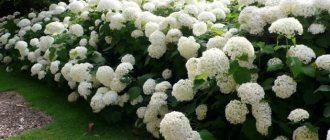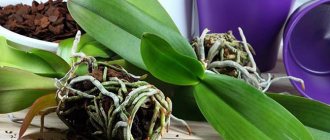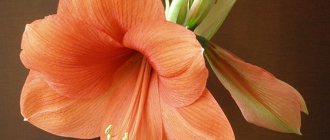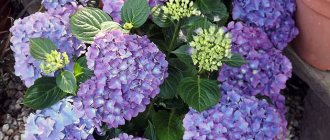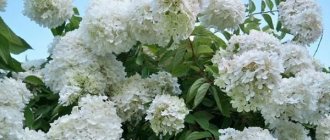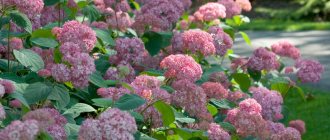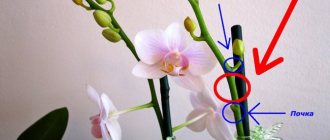Hydrangea is a spectacular and bright flower that pleases the eye with its lush inflorescences and riot of colors. It has long won the sympathy of flower growers and began to be planted in the garden and at home, as a houseplant. The culture is not considered whimsical and does not require special growing conditions. But sometimes the question arises, what year does hydrangea bloom after planting, since often the flowering dates differ significantly.
Hydrangea is a tree or bush plant with paniculate, spherical, sometimes corymbose inflorescences. Each inflorescence contains two types of flowers: small, bisexual (they are located in the middle of the inflorescence) and large, sterile (located at the edges). The color range of hydrangea is varied: from snow-white, cream to deep blue and purple. The timing, period and intensity of flowering depend on where the hydrangea is planted, in the shade or in the sun, on the plant variety, care and weather conditions.
What does hydrangea look like?
The flowering period of different varieties of hydrangea differs; some bloom only for a month and a half. Early varieties of the flower begin to bloom in early June, some varieties are pleasing to the eye until mid-October (the warmer and milder the climate, the longer the flowering, the plant has more time to prepare for the first frosts and go into dormancy).
Flowering calendar by hydrangea varieties
| Hydrangea variety | June | July | August | September | October |
| Anabel | + | + | + | + | |
| Invisibel spirit | + | + | + | ||
| Peppermint | + | + | + | + | |
| Vanilla | + | + | + | + | |
| Pinky Winky | + | + | |||
| Candlelight | + | + | + | + | |
| Phantom | + | + | + | + | + |
| Green Racer | + | + |
Attention! By correctly selecting two or three plant varieties, you can ensure a constant intense flower festival in your garden plot for several months.
What year does hydrangea bloom after planting?
Hydrangea is a spectacular and bright flower that pleases the eye with its lush inflorescences and riot of colors.
It has long won the sympathy of flower growers and began to be planted in the garden and at home, as a houseplant. The culture is not considered whimsical and does not require special growing conditions. But sometimes the question arises, what year does hydrangea bloom after planting, since often the flowering dates differ significantly. Hydrangea is a tree or bush plant with paniculate, spherical, sometimes corymbose inflorescences. Each inflorescence contains two types of flowers: small, bisexual (they are located in the middle of the inflorescence) and large, sterile (located at the edges). The color range of hydrangea is varied: from snow-white, cream to deep blue and purple. The timing, period and intensity of flowering depend on where the hydrangea is planted, in the shade or in the sun, on the plant variety, care and weather conditions.
What does hydrangea look like?
Varieties of flowering hydrangea
- Oakleaf is a fairly frost-resistant variety that can withstand temperatures down to minus 29, and is characterized by abundant color, lobed, oak-like leaves, and large flowers.
- Serrated. The variety is low-growing, has jagged leaves and inflorescences, the diameter of which reaches 8 cm, the color is deep blue and bright.
- Chereshkovaya is a deciduous variety that grows in the form of a vine, reaching a length of up to 25 m. It is most often used by florists for decorating arches and perlogs. Noted by a wide variety of colors and shapes of hydrangea, but especially distinguished by its spicy, strong aroma.
- Garden large-leaved - reaching a height of at least 130 cm, has a pleasant, strong aroma, ovoid leaves and ball-shaped inflorescences, with large flowers reaching up to 3 cm in diameter, most often pink.
- Paniculate - its inflorescences resemble a panicle, reaching a length of up to 25 cm. Growing up to 5 meters, it has large flowers.
- The tree-like variety is noted for its good cold tolerance and abundant flowering. This is a shrub reaching a height of 140-160 cm, with oblong leaves and small flowers collected in inflorescences, most often white.
Hydrangea flowering calendar
The flowering period of different varieties of hydrangea differs; some bloom only for a month and a half. Early varieties of the flower begin to bloom in early June, some varieties are pleasing to the eye until mid-October (the warmer and milder the climate, the longer the flowering, the plant has more time to prepare for the first frosts and go into dormancy).
Flowering calendar by hydrangea varieties
| Hydrangea variety | June | July | August | September | October |
| Anabel | + | + | + | + | |
| Invisibel spirit | + | + | + | ||
| Peppermint | + | + | + | + | |
| Vanilla | + | + | + | + | |
| Pinky Winky | + | + | |||
| Candlelight | + | + | + | + | |
| Phantom | + | + | + | + | + |
| Green Racer | + | + |
Attention! By correctly selecting two or three plant varieties, you can ensure a constant intense flower festival in your garden plot for several months.
How to feed hydrangea?
She is demanding of fertilizers and needs them in large quantities. Feeding is carried out according to the following scheme:
- In mid-May, complex mineral fertilizers are applied at the rate of 30-35 grams per 10-liter bucket of water. You can also add organic matter under the bush - an infusion of chicken manure or mullein diluted in a ratio of 1 to 10, adding it once every 2 weeks.
- In mid-summer, 2 weeks before flowering, add potassium and phosphorus at the rate of 70-75 grams per 10-liter bucket of water. complex fertilizer.
- During the flowering period, repeat the application of potassium-phosphorus fertilizers without using wood ash.
Why doesn't hydrangea bloom?
It is almost impossible to determine what year hydrangea blooms when planting. Under optimal conditions, the crop blooms 2-3 years after planting the seedling. Much depends on the quality of the planting material and on the shoots of what age flowering buds are formed. If peduncles form on the shoots of the first and second years, the flower can bloom the very next year after planting. If only in the second year, the young plant will bloom later.
Another important nuance is that purchased seedlings take a long time to adapt to their natural habitat. In industrial cultivation, the express forcing method is often used - various growth activators are used. They contribute to the rapid development of the plant in the initial stages, but deplete its strength. The recovery process is long - the sprout takes a long time to take root in a new place and stops growing.
Attention! When planting such garden flowers, it is recommended not to radically change the soil: a mixture of turf soil with peat and sand is poured into the hole. Regular watering, spraying, and moderate fertilizer will help the plant recover. An important role in the adaptation process is played by the fact whether the hydrangea grows in the shade - a weakened seedling does not tolerate the scorching sun.
Necessary conditions for hydrangea flowering:
Attention! Some gardeners, in order to protect the plant from frost, replant it in a pot and take it into the house. Low-growing large-leaved hydrangeas can be grown as an indoor flower.
Main mistakes when planting hydrangeas:
Attention! Depending on the acidity of the soil, the color of the inflorescences changes. On neutral soils they will be light pastel shades, on acidic soils they will be rich, bright colors.
Care after flowering
After flowering is complete:
- Remove dried flower stalks.
- Fertilize the plant. They are fed to stimulate the growth of new shoots and protect against rapid growth of shoots; they should not stretch.
- Bushes are being spudded. New soil is poured under each one, making a slide.
- Mulch the soil. A mixture of compost, manure, peat and humus is poured under each bush in a layer of 5 cm.
Removing old flower stalks is necessary to protect the plant. The panicles, swollen from rain and snow, become very heavy. The stems cannot support the weight and break.
At the end of October, hydrangea is protected from frost. If the winter is snowy, then some varieties can be left without artificial shelter, constructing it from snow. Tree, ground cover and tree hydrangeas tolerate cold well.
Removing panicles
Useful tips and secrets of care
In order for the hydrangea bush to bloom at the right time and for a long flowering period, experienced gardeners advise following some recommendations:
Advice! Some gardeners do not even remove the last inflorescences - it is believed that they are able to preserve the plant in severe frosts. In autumn, old plantings are rejuvenated.
Mulching for the winter
Advice! Hydrangea flowers do not have a pronounced aroma, do not attract bees, and can be planted near paths, windows, and doors.
Where to plant hydrangea
The question of where to plant hydrangea: in the shade or in the sun is quite relevant and interests many lovers of these flowers. This is not surprising, because lighting is one of the main factors that influence the flowering and development of a plant.
In conditions of constant deep shade, hydrangea grows well, gains green mass, but does not form flower stalks. In such conditions the plant will not bloom.
Is it possible to plant hydrangea in the sun? It all depends on the duration and angle of sunlight hitting the plant. With constant light, hydrangea succumbs to stress, flowering becomes short-lived and faded. Direct sunlight burns the leaves and prevents flower stalks from developing to their full potential.
Attention! Hydrangea loves the sun, but the light should be diffused and not scorching. The best option is morning and afternoon lighting. The culture grows well in a slightly shaded place, protected from drafts.
Soil composition
The soil should be light, nutritious, permeable and acidic.
Peat chips, compost and crushed pine needles are poured into the hole before planting the bush. Soil acidity is increased using ammonium sulfate, sulfuric acid or ferrous sulfate. They are part of most complex fertilizers.
Drainage is made from a mixture of fine expanded clay and leafy soil. Hydrangea grows well on loam, but it is not suitable for rich black soil. Ideal soil composition:
- turf land;
- peat crumb;
- leaf humus;
- coarse sand;
- black soil mixed with coarse sand.
The main components are taken in equal quantities.
Shelter for the winter is necessary to prevent the bushes from freezing
Rules and terms of feeding
The main rule that must be followed when caring for hydrangea. It is better to apply less fertilizer than to exceed the permissible rate. Feed from March to October.
If a gardener grows some exotic variety, then it should be fed only after consulting with specialists who already have experience in growing it.
Features of planting depending on the region
Climatic conditions have a great influence on the growth and flowering of hydrangea. It is necessary to choose the right plant variety, choose a place for planting and cover the bush for the winter.
In the southern regions, in particular in the Krasnodar Territory, it is advisable to plant hydrangea in a shaded place. You can do without shelter; you need to hill up the bush well and mulch the soil. Planting can be done at the end of autumn.
In the middle zone and Moscow region, you need to choose a slightly shaded area. For the harmonious development of most varieties of paniculata hydrangea, five hours of intense sunlight is sufficient. You need to cover the bush for the winter more carefully: mulch the soil, tie the branches, carefully bend them down, sprinkle them with earth, and cover them with spruce branches or special material. It is advisable to plant hydrangea in mid-autumn, before frost sets in.
Preparing for winter
In the harsh northern regions (Siberia, the Urals), the planting site is chosen to be as illuminated as possible - the sun in these areas is not so intense, the cool climate forces the plant to accumulate as much heat as possible. Hydrangea is prepared for the winter very carefully: it is hilled, mulched, the branches are tied, bent, covered with woven fabric and spruce branches. The top is covered with a box, or a “hut” is built from corrugated sheets. It is necessary to plant the crop in early autumn - the plant needs to strengthen before the onset of cold weather.
Hydrangea winters in a box
Hydrangea is a beautiful, showy plant that, if properly cared for, will decorate the garden throughout the summer. She loves a light sunny color, is thermophilic, but can withstand cold, and grows well in acidic, loose soils.
Source
Growing rules
In order for hydrangea to delight with stable and bright flowering, it needs to organize good conditions for growth, properly plant seedlings and provide them with proper care. It is also very important to properly care for the flower after it has finished blooming.
Preparing the site and soil
In most cases, gardeners practice growing hydrangea from seedlings.
The timing of planting the material will depend on the climatic conditions of the cultivation region:
- in the southern regions, it is allowed to plant the plant in spring or autumn, since the weather conditions of the area allow the crop to take root well and adapt to the new location;
- It is better to postpone planting in the central, northern regions or in the central zone of the Russian Federation to spring, since during autumn planting the flower may freeze before it has time to take root.
For garden hydrangea, it is advisable to choose sunny, spacious areas with slight shading during the scorching sun . It is better if the crop grows away from trees and shrubs with a similar shallow root system, otherwise there will be a struggle between them for moisture and nutrients from the soil.
It is preferable to plant on fertile, light, breathable soils with a weak or medium level of acidity . You can prepare the substrate yourself from identical parts of leaf, turf soil, peat and sand.
Important! When growing hydrangea in alkaline soils, it can be affected by chlorosis, as a result of which the leaves begin to turn yellow and fall off. To prevent the disease, it is recommended to water the bushes once every 10 days with a solution of salts containing iron.
Planting scheme and technique
In the first 3-4 years, the plant grows at a rather slow pace, forming an annual growth of up to 5–7 cm . For this reason, the bushes are planted at a distance of about 15–20 cm from each other. After two years, they are planted, leaving an interval of approximately 1 m between specimens.
Planting of seedlings is carried out using the following technology:
- Dig a hole, the size of which is 1.5–2 times the size of the root system.
- The bottom of the pit is covered with any drainage: broken brick, pebbles, expanded clay.
- The soil removed from the pit is mixed with peat, humus and sand in a ratio of 3:1:1:1 and 1 tbsp is added. l. superphosphate and potassium salts.
- The prepared substrate is poured on top of the drainage layer.
- The seedling is lowered into the hole, the root shoots are carefully straightened and covered with soil so that the neck of the root remains 2–4 cm on the surface, otherwise the plant will quickly rot and die.
- The soil around the crop is lightly compacted, watered abundantly with non-cold water, at least 3-4 liters per bush.
- The tree trunk circle is covered with a layer of peat or pine needles mulch.
To prevent the plant from being damaged by winds, it is tied to a wooden support.
How to care for a flower after blooming
Many gardeners neglect the rules of caring for hydrangea after it blooms . And it’s completely in vain, because such events have a beneficial effect on the condition of the bushes and their further flowering.
After the plant has flowered it is necessary:
- bring the crop that was grown in pots after the first frost, around October, to a cool place, for example, a cellar or basement;
- remove all faded buds from a garden flower, cut off the dried parts, cover the trunk circle with peat mulch;
- when cultivating a flower in the northern zones, cover it with burlap or agrofibre for the winter. Cover dwarf varieties with a cardboard box.
In the spring, when temperatures stabilize and the likelihood of night frosts returning disappears, the shelter is removed.
What year does hydrangea bloom after planting?
The seedling produces flowers the very next year after planting, but individual specimens require 2-3 years to adapt. The specific period depends on various factors:
In the first two years you should not expect inflorescences. Hydrangeas bloom fully only at three years, less often 4-5 years after planting.
What year does paniculata hydrangea bloom?
The paniculate variety blooms for the first time four years after planting. Moreover, it produces inflorescences from the beginning of July until the end of October, if the autumn is warm. The plants are winter-hardy, so they can be grown in different regions, producing beautiful, lush flowers.
What year does large-leaved hydrangea bloom?
Large-leaved hydrangea (pictured) does not bloom fully for very long. Inflorescences appear in only 3-4 weeks.
When and in what month does garden hydrangea bloom?
Most varieties of hydrangeas produce flowers from mid-July to the 20th of September. There are exceptions - some plants bloom in June and end in October.
When does Hydrangea paniculata begin to bloom?
Paniculate varieties produce large (2-2.5 cm in diameter) sterile flowers. Their color changes from pale green, pistachio to pinkish. Buds begin to form four years after planting (subject to proper care). In most cases, they begin to open at the end of June. The last flowers appear in September or even October. They can be seen until the first frost.
Which paniculate hydrangea blooms the earliest?
In general, the flowering of paniculate hydrangeas begins in mid-July and ends in August. But there are also early varieties that bloom 1-3 weeks faster. Here are some of them:
When does tree hydrangea bloom?
Tree varieties produce inflorescences in early July, sometimes from the end of June. Basically, buds appear within six weeks. The last of them can open in September, and if the autumn is warm, then in October. The inflorescences have the shape of hemispheres. The color is pistachio, then pure white, after which it turns greenish again.
The culture is particularly resilient. Tree varieties have good immunity. Such hydrangeas can be grown in almost all Russian regions, including the Urals and Siberia.
How and on what shoots does hydrangea bloom?
Different species can bloom on the shoots of the current and last year. This is important to consider when carrying out spring and autumn pruning.
On which shoots does paniculata hydrangea bloom?
Paniculate varieties produce buds on this year's shoots, i.e. on young green cuttings of the current season. In this case, pruning is classic - in the spring, frozen branches are removed, and in the fall they are thinned out and the crown is formed.
Such plants have high winter hardiness, so even if some of the branches freeze, the bush will be able to recover the next season. At the same time, in regions with extreme winters, mulching and shelter are recommended.
On which shoots does large-leaved hydrangea bloom?
Large-leaved varieties are the only exception to the general rule. Her buds appear on last year's shoots. Therefore, you should not worry that the young branches of the current season did not produce inflorescences - this is a normal phenomenon.
In the spring, it is enough to carry out sanitary pruning by removing frozen and weakened branches. And the shoots of last year will give lush inflorescences, so they need to be left. In the fall, they also don’t need to be removed. Although in old bushes such branches are often pruned to stimulate the growth of new shoots.
Important! Almost all large-leaved varieties do not have good winter hardiness. They are grown mainly in the southern regions.
Some varieties can be cultivated in other areas, provided winter shelter is required.
On which shoots does tree hydrangea bloom?
Representatives of the tree group also produce inflorescences on the shoots of the current year. Therefore, pruning is classic - sanitary in the spring, formative in the fall. Since the shoots are covered with wood, the winter hardiness of the plants is very high. Therefore, they can also be grown in regions with extreme winters - the Urals, Siberia and the Far East.
Ground cover varieties also produce inflorescences only on young shoots of the current season. But in this case, pruning is done according to a different pattern. In autumn, all long branches are shortened - this is quite enough. Then the plantings are mulched for the winter.
How petiolate hydrangea blooms
Chereshkovaya is a subspecies of garden hydrangea. It is decorative thanks to its large leaves, climbing shoots and beautiful flowers of delicate colors - from white to light purple and pink. The inflorescences are corymbose, located on the vine. Like garden hydrangea, petiolate blooms for quite a long time, for 8-9 weeks in a row, usually more than two months.
Moreover, the first flowers appear already in mid-June, i.e. 3-4 weeks earlier than most other hydrangea varieties. The last buds form at the end of August. After planting, petiole varieties can begin to bloom for 2-3 years, sometimes later. It all depends on the characteristics of the variety, weather conditions and care.
Pruning hydrangea paniculata
Pruning paniculata hydrangea can be done late in the fall, after the leaves fall, but it is better in the spring, before the beginning of the growing season.
For young plants, formative pruning is necessary. If the plant is small and consists of 2-3 short twigs, spare no expense in cutting them in the fall at a height of 20-25 cm to good buds to stimulate tillering. Larger seedlings are shortened by a third, weak and damaged shoots are removed. The purpose of formative pruning is to get more strong shoots.
Container plants purchased from a nursery are often larger, more established, and already have several stems. They, like plants already grown in the garden, undergo regular pruning in the spring. It consists in shortening the shoots to a pair of strong buds, which are capable of producing good inflorescences on the current year's growth; at first, a quarter or a third of the length of the shoots has to be cut off. They also cut off shoots that are too long and thin, and remove crowns that rub and grow inward and are frozen. This pruning should be done annually. With age, you will also have to cut out too old shoots so that they are replaced in a timely manner by young shoots.
Hydrangea paniculata Grandiflora, standard
Here it is worth addressing the issue of pruning faded inflorescences. It is often written that dry inflorescences look decorative even in winter, in frost and snow caps, so it is better to cut them in the spring. In my opinion, it is still better to prune the inflorescences in the fall, especially for older varieties with thin stems. In heavy snowfall and freezing rain, branches may break off. The risk of breaking by snow increases especially if the bush has been formed into one trunk and resembles a standard tree in appearance. It is necessary to strive for a multi-stemmed habit. Only the caps of inflorescences are cut off; the main pruning is carried out in the spring, leaving 3-5 strong buds on annual growths.
The standard forms, which are offered by nurseries, in youth and especially in winter, must be tied to a support. They do not need to leave a wide crown, cutting the shoots to strong buds and rounding the shape.
If pruning is neglected, over the years the bark on old hydrangea stems cracks, the crown thickens with random weak shoots, the bottom of the bush becomes bare and the inflorescences appear only at the top. And the intensity of flowering itself decreases.
But we can fix everything. Hydrangea paniculata tolerates strong anti-aging pruning well, even on a stump, to a height of 10-15 cm from ground level. She is durable, 30 years is not an age for her, she is quite capable of living twice as long.
Spring pruning must be combined with fertilizing. It is most convenient in early spring, without delay, to apply long-acting granular fertilizer under the mulch, then you will not have to worry about summer fertilizing.
How long does hydrangea bloom in the garden?
The duration of hydrangea flowering also depends on the characteristics of the variety, care and weather conditions. Today, several hundred varieties have been bred that produce flowers from 1.5 to 4 months in a row. There are no hard restrictions. For example, if the weather is good, then even a hydrangea with a standard flowering period will produce buds until the end of October.
Advice! To create a beautiful flower garden, you need to select hydrangeas with different flowering periods - early, middle and late. Then the garden will always be beautiful, and the buds will open almost continuously.
When and how long does indoor hydrangea bloom?
Unlike garden varieties, indoor hydrangea blooms already in May. Moreover, the last buds appear not only in September, but also in October. Theoretically, they can form in winter. But the plant needs to be allowed to rest, eliminating fertilizing, frequent watering and lighting from October.
As for specific dates, they depend on the characteristics of the variety. Typically, plants produce flowers within 1-2 years after planting. With proper care, plants take root well and develop quickly.
Advice! To ensure maximum flowering time, it is recommended to feed with superphosphate and potassium salt from the end of June to the last days of August.
Nitrogen fertilizers are given only in spring and early summer, since they stimulate the growth of green mass, not buds.
Propagation of hydrangea paniculata
So, we will not touch on seed propagation. Mostly varieties are cultivated, and they propagate vegetatively.
The shoots remaining from pruning are cut into cuttings with 4 pairs of buds, dusted with Kornevin and planted in loose soil fertilized with compost. Cover with non-woven covering material. Plants that have begun to grow are watered regularly. The non-woven material is removed in August, when the hot days have passed. For the winter, the school with young plants is covered with spruce branches. The rooting rate of cuttings with proper care reaches 100%.
It is easy to propagate the plant by layering - the shoot is bent to the ground, secured with a wire pin and sprinkled with soil. Separated after a year.
Why hydrangea does not bloom and what to do
Often gardeners are faced with the fact that hydrangea produces few buds or does not bloom at all. This phenomenon may have objective reasons, for example, characteristics of the variety, acclimatization in a new place, unfavorable weather conditions. But most often they are associated with care and planting conditions:
First of all, you need to pay attention to pruning. In autumn, in the second half of October, it is necessary to thin out the crown and remove old branches. In the case of large-leaved varieties, last year's shoots must be left in place - they are the ones that will produce buds next year.
With the onset of spring, they carry out a sanitary haircut, and also shorten the stems by several centimeters. Moreover, this must be done in March or early April, before the sap begins to flow. Otherwise, the bush can be seriously damaged and even get sick.
It is known that hydrangea produces normal inflorescences only in acidic soil. The optimal pH value is in the range of 5.5-6.0. If the environment is neutral or even alkaline (pH greater than 7.0), there will be few buds, and the color of the petals will change greatly. Therefore, before planting, it is recommended to measure the acidity level, for example, using indicator paper. If necessary, you can water the soil with a weak solution of 9% vinegar (100 ml per 10 liters of water per 1 m2 of soil).
Prevention of diseases and pests
Hydrangea does not often, but gets sick and suffers from pest attacks. Gardeners should be wary of the following diseases:
- chlorosis – the color of the leaf plate changes, the plant becomes weak, unable to survive in possibly difficult climatic conditions;
- white rot - affects the root system, which leads to the death of the entire bush;
- gray rot;
- septoria;
- powdery mildew;
- rust;
- ring spot is a viral disease that manifests itself in the form of spots on the leaves and cannot be treated.
Gray rot is dangerous for flowering bushes
Bushes are affected by leaf aphids, spider mites and slugs. To prevent plant death:
- Choose the right planting site - close proximity to groundwater can lead to rotting of the roots.
- Water regularly - lack of watering weakens the flowers, they become less resistant to diseases and pests.
- They feed - nitrogen must be added to the soil in May, phosphorus and potassium in the summer, and only phosphorus in the fall.
- The bushes are treated with copper sulfate, dissolving 100 g of it in 10 liters of water.
To control pests, poisonous agents such as Topaz or Fitosporin are used. In addition, they regularly weed the ground under the bushes, and also inspect the plants for pest damage. Dry leaves and branches are removed.
Important! After heavy watering or heavy rains, the soil under the hydrangeas is loosened. They do this carefully, trying not to damage the roots and give them access to air.
What year does hydrangea bloom after planting?
Hydrangea is often used to decorate flower beds and lawns in the private sector. This plant is quite bright and attractive. But most inexperienced gardeners sometimes have a question: for what year does hydrangea bloom after planting, and how much care does it require?
This article discusses all the rules for planting and caring for a garden plant so that it pleases its owners with an attractive appearance.
What year does hydrangea bloom after planting?
As a species, hydrangea can be represented in several forms:
In their garden plots, gardeners prefer to grow the deciduous form of the plant in the form of a bush, although in nature there are also evergreen varieties of hydrangea.
The leaves of the shrub form can be very different in shape - oval, elongated, have a jagged edge or brightly traced veins.
The inflorescences are quite large, and their shape can be:
Corymbose inflorescences of the plant
As for the color, it can be very diverse: from white to deep purple, plain or tinted (when the color changes as the buds bloom).
In addition, many gardeners are also concerned about this point: in what year does hydrangea bloom after planting a cutting?
It is worth noting that if a hydrangea is planted in the autumn, then in most varieties the inflorescences will begin to form the next summer, that is, in fact, when the plant is not yet 1 year old.
But there are other varieties that take several years to produce their first buds.
Flowering calendar for garden hydrangea varieties
Growing hydrangea is not difficult, but it is important to choose the variety that is suitable in each specific case, taking into account its flowering period.
For example, the tree variety is characterized by cold resistance and lush, massive flowering, which lasts from June to the end of September.
Paniculata hydrangea can bloom only in the fourth year after it was planted. As for the duration of flowering, this plant will bloom in July and fade by the end of October. There are a wide variety of paniculate hydrangea varieties, which differ in different flower colors.
Large-leaved hydrangea has a short flowering period, which lasts about a month (from approximately July to August).
The serrated subspecies has white or blue flowers. It blooms for about 2-3 months, depending on the conditions created.
Hydrangea radiata is distinguished by snow-white flowers that will delight the owner of the garden for 2 to 3 months.
The oakleaf subspecies has snow-white formed inflorescences that gradually change their color, first to pink, and then to a rich purple color.
Why doesn't hydrangea bloom?
There are several reasons why a plant does not bloom, most of which depend on the variety:
Causes such as diseases and various types of infections may also be common to all types. Fungus, powdery mildew or gray mold have a very negative effect on the bush, including its flowering.
Necessary conditions for hydrangea flowering
Many inexperienced gardeners do not know where to plant hydrangea: in the shade or in the sun. This is a very important parameter on which a lot depends.
Hydrangea loves well-lit areas, open but without drafts. At the same time, if direct sunlight falls on the plant for a long period of time, this will negatively affect the appearance of the bush.
Optimal growing location
It is also necessary to select a site whose soil will meet the requirements. It should be slightly acidified and not heavy. The plant does not tolerate clay soils very well. If the land does not comply, then you will have to bring it to the required parameters by adding certain purchased factory microelements, a small amount of sand and peat.
Common mistakes when planting hydrangeas and how to avoid them
Not everyone knows how and where to plant hydrangea: in the shade or in the sun, so that it produces lush flowers.
If such a beauty grows in the garden, but the problem is that it does not bloom, it means that it was not provided with the appropriate conditions. Most likely, the place is too shady for her. The fact is that the bush is quite sensitive to the amount of lighting. If there is not enough sun, the bud simply will not form.
There is another common mistake that inexperienced amateur gardeners make. They place other garden crops too close to the hydrangea. As a result, intertwining, the root systems do not allow each other to fully develop. Therefore, in order for it to bloom, it is necessary to grow it at a certain distance from other neighbors.
Useful tips and some secrets of caring for paniculata hydrangea
First of all, a gardener needs to know whether hydrangea loves sun or shade. In this case, the amount of sunlight should be abundant, but with slight shading, occurring during the period when the sun is at its zenith. These are the most suitable conditions for garden hydrangea to bloom abundantly and for a long time.
If the plant nevertheless begins to bloom, but forms rather small brushes or spheres, then the reason may lie in the fact that the soil does not have enough minerals that provide nutrition to the plant. But you need to be careful with nitrogenous fertilizers, as they affect the amount of green mass formed, and, on the contrary, have a negative effect on the formation of flowers. With hydrangea, you need to adhere to the principle - it is better to underfeed than to overdo it in adding nutrients, be they mineral or organic.
It is also necessary to adhere to the recommended pruning pattern. This will not only help to form a visually attractive bush, but will also contribute to the formation of a large number of flowers.
Where to plant hydrangea: in the shade or in the sun
Since the capricious and contradictory hydrangea does not tolerate excess moisture in the soil, you should choose a good, flat area, slightly elevated above the general soil level. It is also necessary to take into account that hydrangea loves the sun, but not too much of it. Therefore, you need to try to ensure that the young plant, after sowing or planting cuttings, receives maximum lighting in the morning and evening hours. If many other plants are planted on the site, then the question may arise as to whether hydrangea grows in the shade. Experienced gardeners answer that the bush, of course, will increase in size, but it will either bloom very poorly, or completely shed or not form a bud.
Is it possible to plant hydrangea in the sun?
In addition to the fact that hydrangea does not like intense shade or semi-shaded areas throughout the daylight hours, it tolerates the sun quite well.
Hydrangea with discolored flowers
You can plant cuttings of a young plant along a retaining wall or fence - this way there will be a lot of light and direct sun during one half of the day, while shade will be provided during the second. These are the most optimal conditions for her.
Features of autumn planting of hydrangea in the Moscow region in Siberia in the Urals in the Krasnodar Territory
Growing a plant in central Russia will require preliminary preparation. The seedling must be placed in a slightly shaded place. If you provide reliable protection for the winter, then next summer there will be abundant flowering.
In the southern regions, including the Krasnodar Territory, it is necessary to intensively shade hydrangeas during the daytime sun. Therefore, it is necessary to carefully select a planting site.
Thus, it becomes clear whether hydrangea can be planted in the sun, regardless of its type. If you provide it with proper care, it will delight you with its beautiful appearance and will become a real decoration of the garden.
Video
Source
How to prepare hydrangea for winter.
After the hydrangea has bloomed, caring for the plant does not end; now it is important to prepare it for wintering. If you grew hydrangea in containers, then in winter you need to move it to a dark, cool place, for example, to a basement. Periodically water the soil moderately, and when winter ends, bring the plant out into the light.
For hydrangeas growing in open ground, you need to remove all the inflorescences and leaves, hill up the base of the bush and mulch the soil with a thick layer of spruce branches, dry leaves or sawdust. After this, the branches should be bent to the ground, first placing boards or spruce branches, secured, covered with earth or leaves, and then with geotextiles. If the hydrangea branches are not flexible enough, they are collected in a bunch, covered with spruce branches and wrapped around several layers of geotextile or burlap. Low seedlings can be covered with a box and the inner space filled with dry leaves.
In the spring, the shelter should be removed gradually, focusing on the weather forecast. It is not recommended to use plastic film to cover hydrangeas, as the plant may rot under it.
